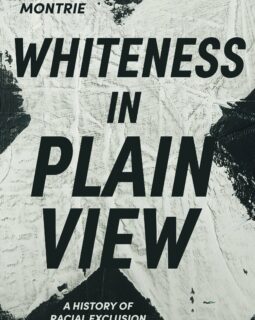Chad Montrie
St. Paul, MN: Minnesota Historical Society Press, 2022
272 pages; 26 b/w photos and 4 maps, notes, bibliography, index; $19.95
Reviewed by Renoir Gaither
Chad Montrie’s book, Whiteness in Plain View: A History of Racial Exclusion in Minnesota, examines racial exclusion around job and housing discrimination meted out to African Americans. The book sutures together haunting narratives that recover “haints” of past and present racial injustices sorely glossed over by white amnesia.
Meant to upend passivity around racial capitalism and the ideological work that whiteness develops, the book centers control over Black labor and the provisions necessary for its reproduction, such as housing—as fundamental to settler colonialism in early Minnesota as in late capitalism. Montrie provides readers with a deeper, more critical analysis of control structures and how they operate.
The book is an essential addition to past state histories. Previous books, such as William D. Green’s A Peculiar Imbalance: The Rise and Fall of Racial Equality in Early Minnesota (2007), Christopher P. Lehman’s Slavery’s Reach: Southern Slaveholders in the North Star State (2019), and Paul D. Nelson’s Fredrick L. McGhee: A Life on the Color Line, 1861-1912 (2002), examine early stages of racial exclusion and counteractive liberation struggles to obtain political and social equality for African Americans in Minnesota. David V. Taylor’s African Americans in Minnesota (2002) gathers a concise history of African American community organizations, influential leaders, and the development of Black communities in several major cities around the state. Montrie’s book complements these manuscripts by broadening analysis and geographic scope of Black urban development, housing and employment discrimination, and community organizing efforts in urban and rural Minnesota communities.
The author’s histories support his argument that white supremacist ideology was not only pervasive among Minnesota’s early white settlers but provided a rationale for the forced removal of Indigenous people and efforts to codify racial inequality for Black migrants during the antebellum, postbellum, and Jim Crow periods. Well-documented and often poignant, his narratives weave together personal and institutional stories that seethe with powerful emotion and indignation over racial discrimination.
Included are histories about white responses to postbellum Black migration to Minnesota—in particular, St. Peter in Nicollet County, Red Wing in Goodhue County, and Hastings in Dakota County in the latter half of the nineteenth and early twentieth centuries. These often resulted in Black retreat from these areas in response to limited occupational opportunities, and, in many cases, open hostility—the infamous Duluth lynchings of June 15, 1920; mob violence against Black strikebreakers at the 1922 Chicago, Milwaukee, and St. Paul Railway roundhouse attack in Austin; and discriminatory housing practices in Edina, Bloomington, and St. Paul in the 1950s and ’60s.
Whiteness in Plain View provides a strong entry point for readers interested in the evolution of efforts to create fair housing and employment practices in Minnesota. Montrie’s skillful analysis and use of credible and varied source materials, including court testimonies, NAACP records, interview transcripts, and other materials is admirable. The book’s geographic scope helps readers better understand and appreciate historical institutional barriers to full citizen rights and economic opportunities afforded to African Americans. Included are archival photographs, maps, and illustrations that relate well to surrounding content, along with bountiful notes and a well-organized bibliography.
For Montrie, the current racial order is a consequence of the historic role of majority efforts to exclude and contain Black residents through an evolving set of means—from government aid to collusion with private mortgage lenders and real estate agents and from extralegal racial violence, intimidation, and threats to ideological tools such as discriminatory media and educational institutional practices and policies.
The book’s argument revolves around the fossilization of racial exclusion through a perverse and pervasive adoption of historical amnesia and fiction-making that erect false explanations and absolution for recurring racial injustice. Such hauntings deserve collective reckonings, and Montrie’s collection of histories hails a well-deserved exorcism.
Renoir W. Gaither is a poet and former academic librarian. He has held positions at the Shapiro Undergraduate Library at the University of Michigan and Magrath Library at the University of Minnesota. He is a member of the Ramsey County Historical Society Editorial Board.
